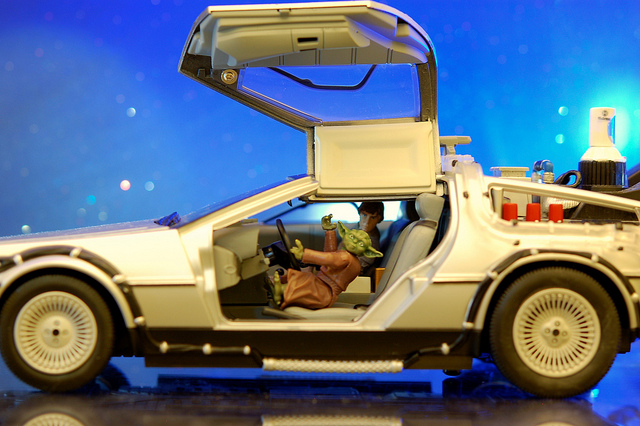Today’s exercise focuses on the best concepts you can dream up so your organization can thrive in the future. You’ll then need to perform a reality test on those ideas, using research you’ve developed.
This article follows up on
my first, in which I argue that now is the time to prepare for what I call “Agency 2020.” In other words, you need to prepare your organization for the leap that will be required for future prosperity.
In that first article, I asked dozens of questions to help define the current reality of 2014. We searched for the knowns – and the known unknowns – of today. This time around, almost every question will be about a discovery in the “unknown unknowns.”
Your challenge is about asking the right questions – and then stretching yourself beyond your comfort zone to find good answers for tomorrow. Use a flood light on the dark horizon of tomorrow. It’s premature to focus with laser-like intensity.
Pursue this process with enthusiasm and childlike curiosity. Forget what you know and believe. Ask “what if?” Don’t try to define “what isn’t.” My intent is to broaden your horizon, stimulate imaginative thought, encourage you to focus and help you act as you develop your new organization for 2020.
To keep the process simple and open-ended, we’ll focus on four issues:
- people
- technology
- the global economy
- innovation
PEOPLE: The overriding challenge and opportunity in 2020 will be people: who they are, their values, the cultures they will create and their wants and needs in their own world. Do their worlds and your world overlap? Is there some common interest and opportunity? How do you communicate with many … as well as with a niche of one?
Research the generational mix in 2020. What percentage of the population will be Gen C, Millennials, Gen X and Boomers? Will the Greatest Generation be gone? What will be the influence of each group in the decision-making process as consumers, managers, leaders, etc.?
If they are clients or prospects, what products and services can you offer to meet their wants and needs? How do you profitably deliver this at a price they are willing to pay? What message, media, metrics are necessary to ensure you maintain intimacy continually with each person and affinity, as well as with their population (generation) – however they define it?
Where and how can your interests align – whether as employers, employees, collaborators, competitors, decision makers, policy leaders, educators, friends or social media group members, etc.? Who is now – or who will be – in your world tomorrow, in 2020?
Consider the following as you try to put your arms around a new digital universe that will see the LAGgards (Last Analog Generation) leaving the scene and new Gen C – digital natives – begin to assert their influence before they finish high school. (Before you roll your eyes, have you ever had to ask a teenager to show you how to use your device
du jour?)
John Naisbitt painted the picture of this phenomenon in his book
Megatrends when he talked about “balancing high tech and high touch.”
If you are unwilling or unable to accept the new world, demographics and diversity, enjoy your retirement.
TECHNOLOGY: Decades ago, the scholar and organizational consultant Warren Bennis observed: “The factory of the future will have two employees, a man and a dog. The man is there to feed the dog, and the dog is there to keep the man away from the machinery.” Could he be right?
To provide perspective, remember that in 2003 the BlackBerry was considered state-of–the-art technology. Some believed this device owned the future of social connection. There was no iPhone, iPad, Facebook, Twitter, etc. By 2012, BlackBerry’s parent – then known as Research in Motion – was teetering on the edge of bankruptcy, and “i” technology, smart devices and social media were out-of-control adolescents.
Today, conversations are focusing on the Internet of Things, or IoT, where inanimate objects – smart watches, “intelligent” cars, home appliances, etc. – communicate without the intervention of people.
In 2020, will technology work for us, or will we work for technology? Will we know more and communicate better than Siri, or will artificial intelligence be the trusted advisers for most consumers? Will facial recognition technology allow your iPhone to read the mood of your clients better than you can, when you’re each sitting at the City Club texting each other over lunch?
Is this ridiculous? Can you afford to be wrong?
THE GLOBAL ECONOMY: Time and place are gone. The lights are always on, and the door is never locked in any place of business. That’s the good news: You can live on Main Street and still compete in Dublin, Dubai or Duson, La. The bad news is that your competitor and many hackers are on Main Street, peering into your shop. You can be a David in a world of Goliaths. But if you’re a Goliath, you’re more vulnerable than ever to a world of Davids. If your company is bureaucratic, you’re just a slower Goliath.
My best suggestion is to “capture population” and become the portal of choice for members of that universe. Don’t worry about selling products. Instead, focus on needs and solutions to problems. Facilitate the “buying,” or capture, of each individual in the group. Remember: If you control a large enough population, you can “insure” needs of the group – without the cost of issuing individual policies.
INNOVATION (the new power plays and power players): In a presentation on change in 1993, I declared: “Today GM, Sears and IBM are the kings of their respective jungles. In our lifetime, one of these companies will fail.” The audience shook their heads in disbelief. I was right, and in the long term I may win the trifecta.
From the Affordable Care Act, to Facebook, Amazon, Twitter, apps, artificial intelligence and IoT, the marketplace is being redesigned by the people who shop there. In other words, the deck is being reshuffled. Opportunities have never been greater, the stakes higher or the risks greater.
That the world will be different is a fact. Remember Einstein’s admonition: “Insanity is to continue to do what you’ve always done and expect a different result.” Don’t be insane. Be prepared. It can work. As I noted in my first article, we’ve already walked on the moon!
With forethought, an organizational purpose, principles, a vision, a commitment and a plan that ropes you to that commitment, you can and will prevail. Don’t try to conquer the world. Just identify and prevail in your part of that world.
Be bold and wise in your research and positioning for 2020. Today’s world includes unlimited data, much less useable information and less still actionable knowledge. By 2020 – if you’re willing to try – you’ll be able to take the actionable knowledge, shape it to the wants and needs of a specific group, align your offerings (helping them buy) and innovate your processes to ensure you can deliver at a price they are willing to pay. Align your message, media, meaning, etc. to each specific group. Test the concept. And then act – meaning experiment. Remember, wisdom exists at the intersection of knowledge and experimentation. When you fall down, stand back up.
As business management columnist Dale Dauten states: “Different isn’t always better, but better is always different.” Be better in 2020. Differentiate yourself from the sameness of today and tomorrow! Take the giant leap of discovery for yourself … and all of mankind!


